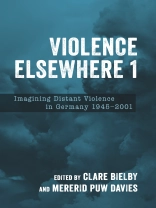<b>Explores the significance of postwar German representations of violence in other places and times.</b>
Germany's twentieth-century history has made imagining and representing violence in German culture challenging, meaning that it can be difficult to locate and explore critically the significance of violence in and for the postwar German states. This volume approaches that challenge through critical analysis of "violence elsewhere, " that is, constructions of violence in distant, imagined, or temporally distinct times and places. Such representations have offered a stage on which to imagine violence. Moreover, German representations of "violence elsewhere" are simultaneously images of Germany itself, revealing something about otherwise submerged meanings and functions of violence in German culture.
The essays in this volume explore selected, emblematic works from East, West, and, later, unified Germany, which imagine violence in, for example, Latin America, Vietnam, Cambodia, the USA, and the Middle East, as well as in the respective "other" German state and in the German past. Drawing on fields including cultural, literary, film, visual, and gender studies, it introduces multidisciplinary theoretical approaches to the topic of violence elsewhere that may be transferable beyond German studies too. As such, the volume allows us to reflect more broadly on relationships between violence, culture, community, and the creation of identities, and to look beyond binary notions of "here" and "elsewhere, " "self" and "other." It thus expands our understanding of what German culture is and could be.
Edited by Clare Bielby and Mererid Puw Davies. Contributors: Seán Allan, Martin Brady, Evelien Geerts, Katharina Karcher, J.J. Long, Ernest Schonfield, and Katherine Stone.
Chapter 8, <i>"Problematizing Political Violence in the Federal Republic of Germany: A Hauntological Analysis of the NSU Terror and a Hyper-Exceptionalized "9/11" </i> is available as Open Access under the Creative Commons license CC BY-NC-ND. The open access version of this publication was funded by the European Research Council.
This book is available as Open Access under the Creative Commons license CC BY-NC-ND.
Cuprins
List of Illustrations
Acknowledgments
Introduction – <i>Clare Bielby and Mererid Puw Davies</i>
1. Projecting Violence Elsewhere: Remembering Conflict-Related Sexual Violence in Cold War Germany – <i>Katherine Stone</i>
2. Watching Violence Elsewhere: Louis Malle's <i>Viva Maria!</i> in 1960s West Germany – <i>Mererid Puw Davies</i>
3. Images as Weapons: DEFA, Studio H&S, and the Global Cold War – <i>Seán Allan</i>
4. <i>Kriegs Erklärung </i>(Declaration of War): Volker Braun's Cold War Camera – <i>J. J. Long</i>
5. The Vietnam Veteran in Anna Seghers's <i>Steinzeit</i> (Stone Age, 1975) – <i>Ernest Schonfield</i>
6. "So It Has to Be Said: Hammer and Sickle Here, Hammer and Sickle There": Heynowski-Scheumann's <i>Die Angkar </i>(1981) and the Problem of <i>Khmer Rouge</i> Violence for the GDR – <i>Martin Brady</i>
7. Narrating Violent Agency Elsewhere in Inge Viett's <i>Nie war ich furchtloser</i> (Never Was I More Fearless, 1996) – <i>Clare Bielby</i>
8. Problematizing Political Violence in the Federal Republic of Germany: A Hauntological Analysis of the NSU Terror and a Hyper-Exceptionalized "9/11" – <i>Katharina Karcher and Evelien Geerts</i>
Selected Bibliography
Notes on the Contributors
Index
Despre autor
<b>Katherine Stone</b> is an Associate Professor in German Studies at the University of Warwick












